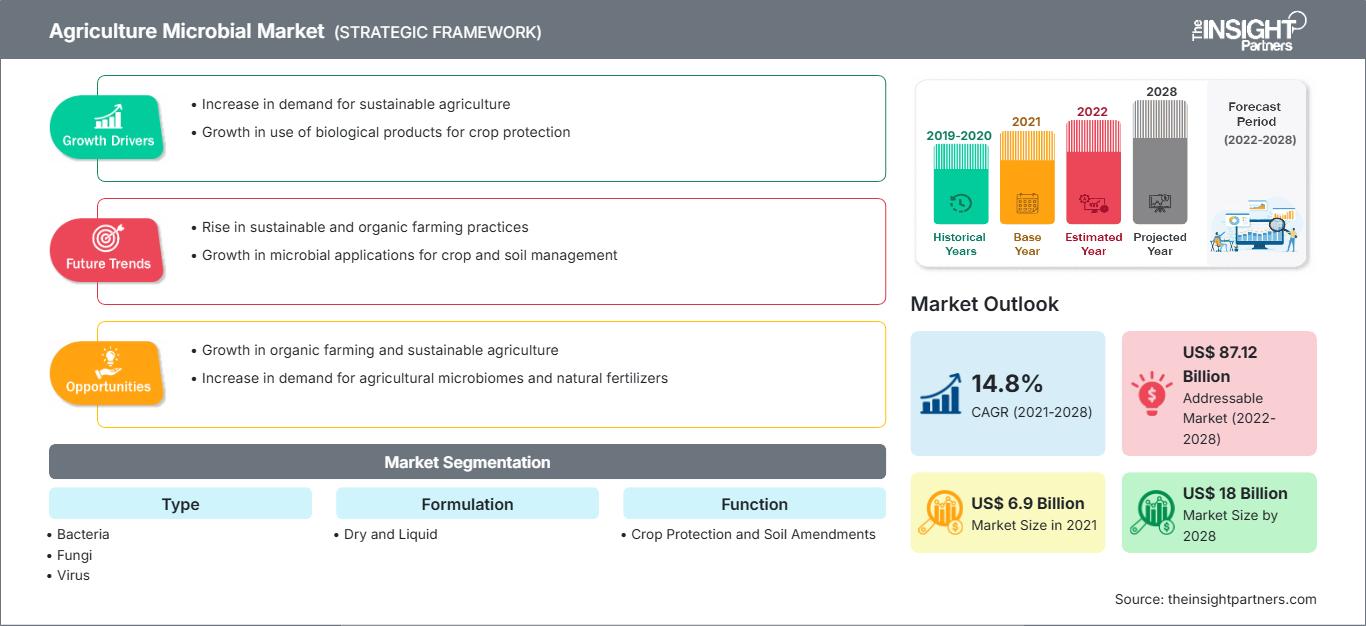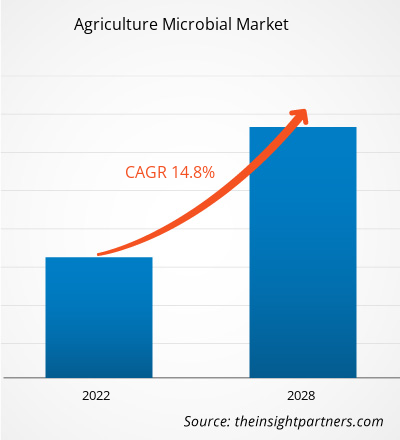Der Markt für Agrarmikroben hatte im Jahr 2021 einen Wert von 6.901,93 Millionen US-Dollar und wird von 2022 bis 2028 voraussichtlich mit einer durchschnittlichen jährlichen Wachstumsrate (CAGR) von 14,8 % wachsen, so The Insight Partners.
Agrarmikroben sind Mikroorganismen, die in der Landwirtschaft eingesetzt werden, um die Produktivität und Ertragsqualität von Nutzpflanzen zu steigern. Bakterien, Pilze und Viren sind einige Mikroben. Sie können das Pflanzenwachstum fördern, indem sie den Zugang zu Nährstoffen verbessern. Viele Mikroben helfen beim Abbau organischer Stoffe und beim Recycling landwirtschaftlicher Abfälle. Darüber hinaus liefern sie Phosphor, Stickstoff und andere Nährstoffe und bieten Vorteile wie Hitze- und Trockenheitstoleranz sowie Resistenz gegen Insekten und Pflanzenkrankheiten.
Im Jahr 2020 hatte Nordamerika den größten Anteil am globalen Markt für Agrarmikroben, und der asiatisch-pazifische Raum wird im Prognosezeitraum voraussichtlich die höchste CAGR verzeichnen. Nordamerika ist eine der wichtigsten Regionen für diesen Markt, da das Bewusstsein für die Vorteile des Einsatzes von Mikroben gegenüber synthetischen Chemikalien in der Landwirtschaft zunimmt. Der Einsatz synthetischer Chemikalien wird unwirksam, da sie Resistenzen gegen Schädlinge entwickeln und die Ernte schädigen. Mikroben in der Landwirtschaft sind praktisch und zersetzen sich selbst in kleinen Mengen schnell, was zu einer geringeren Belastung führt und die durch synthetische Chemikalien verursachten Umweltprobleme verhindert.
Darüber hinaus treiben die zunehmend umweltfreundlichen und biologischen Anbaumethoden das Wachstum des Marktes für mikrobielle Landwirtschaft voran. Laut der Organic Survey 2019 des US-Landwirtschaftsministeriums (USDA) gab es in den USA im Jahr 2019 16.585 Bio-Bauernhöfe, ein Anstieg von 16,7 % gegenüber 2016.
Passen Sie diesen Bericht Ihren Anforderungen an
Sie erhalten kostenlos Anpassungen an jedem Bericht, einschließlich Teilen dieses Berichts oder einer Analyse auf Länderebene, eines Excel-Datenpakets sowie tolle Angebote und Rabatte für Start-ups und Universitäten.
Markt für landwirtschaftliche Mikroben: Strategische Einblicke

-
Holen Sie sich die wichtigsten Markttrends aus diesem Bericht.Dieses KOSTENLOSE Beispiel umfasst Datenanalysen, die von Markttrends bis hin zu Schätzungen und Prognosen reichen.
Vor der COVID-19-Pandemie wurde der Markt für Agrarmikroben hauptsächlich durch die zunehmende Nutzung des ökologischen Landbaus und die wachsende Nachfrage nach nachhaltiger Landwirtschaft angetrieben. Viele Branchen standen jedoch aufgrund der Pandemie im Jahr 2020 vor beispiellosen Herausforderungen. Die Landwirtschaft erlebte einen Rückgang aufgrund der Schließung mehrerer Produktionsstätten und Unterbrechungen der Lieferkette. Im Jahr 2021 nahmen jedoch verschiedene Volkswirtschaften ihren Betrieb wieder auf, da die Regierungen Lockerungen der zuvor verhängten Beschränkungen ankündigten, was sich positiv auf den Weltmarkt auswirkte. Darüber hinaus durften die Hersteller mit voller Kapazität arbeiten, was ihnen half, die Lücke zwischen Angebot und Nachfrage zu schließen. Aktuell ist die Marktlage deutlich besser als zuvor. Viele Länder sind vollständig geimpft, und die Hersteller landwirtschaftlicher Mikrobenprodukte konzentrieren sich darauf, ihre Produktion zu steigern, um ihre Umsätze zu erhöhen.
Der Arbeitskräftemangel in den Produktionsstätten und der Einbruch des Vor-Ort-Verkaufs durch Distributoren und Einzelhändler aufgrund der darauffolgenden Lockdowns und Ladenschließungen bremsten den Markt für Agrarmikroben. Trotz der schweren Einbußen durch die COVID-19-Pandemie berichteten mehrere Unternehmen, dass die Branche bis Ende 2020 eine steigende Nachfrage nach nachhaltigen Agrarprodukten verzeichnete. Aufgrund der zunehmenden Knappheit an Agrarprodukten lockerten verschiedene Regierungen jedoch die Beschränkungen für Agrarrohstoffe, um die Nachfrage nach Nahrungsmitteln zu decken.
Markteinblicke: Steigende Akzeptanz des ökologischen Landbaus treibt den Markt für Agrarmikroben an
In den letzten Jahren wurde der ökologische Landbau weltweit eingeführt, um Nachhaltigkeit zu erreichen und die schädlichen Auswirkungen auf die Umwelt zu verringern. Zu den Vorteilen des ökologischen Landbaus zählen eine geringere Bodenerosion, eine verringerte Nitratauswaschung ins Grund- und Oberflächenwasser sowie die Verwendung von recycelten Tierabfällen in landwirtschaftlichen Betrieben. Das gestiegene Bewusstsein für die Vorteile hat die Nachfrage nach ökologischer Landwirtschaft stark ansteigen lassen. Laut der Organic Survey 2019 des National Agricultural Statistic Service gab es in den USA zwischen 2016 und 2019 einen Anstieg von 17 % bei zertifizierten Bio-Bauernhöfen. Laut der Ernährungs- und Landwirtschaftsorganisation (FAO) der Vereinten Nationen wurde 2019 in 187 Ländern ökologische Landwirtschaft betrieben und rund 72,3 Millionen Hektar landwirtschaftliche Nutzfläche biologisch bewirtschaftet. Mehrere Regierungen in Entwicklungsländern legen großen Wert auf die Einführung des ökologischen Landbaus. Agrarmikroben spielen in der ökologischen Landwirtschaft eine entscheidende Rolle für die Bodenbewirtschaftung, da sie nicht durch synthetische Komponenten ersetzt werden können. Bodenmikroben, darunter Bakterien, Pilze und Viren, erfüllen grundlegende Funktionen im Boden, wie den Abbau von Ernterückständen, den Kreislauf wichtiger Nährstoffe wie Stickstoff und Kohlenstoff und die Stimulierung des Pflanzenwachstums. Daher treibt die zunehmende Einführung des ökologischen Landbaus die Nachfrage nach Agrarmikroben aufgrund ihrer Vorteile in der ökologischen Landwirtschaft an.
Einblicke in Typen
Basierend auf dem Typ ist der Markt für Agrarmikroben in Bakterien, Pilze, Viren und andere unterteilt. Das Bakteriensegment wird im Prognosezeitraum voraussichtlich den größten Marktanteil und die höchste durchschnittliche jährliche Wachstumsrate (CAGR) halten. Pilze gehören zu den wichtigsten Bodenmikroben für den Abbau organischer Stoffe und das Recycling von Pflanzenabfällen. Darüber hinaus erfüllen sie wichtige Funktionen im Zusammenhang mit der Wasserdynamik, dem Nährstoffkreislauf und der Krankheitsbekämpfung. Beispielsweise verbinden sich Pilzhyphen physikalisch mit Bodenpartikeln und bilden stabile Aggregate, die die Wasserspeicherkapazität des Bodens bei Pflanzen und die Wasserinfiltration verbessern.
Einblicke in die Formulierung
Basierend auf der Formulierung wird der Markt für Agrarmikroben in Trocken- und Flüssigformulierungen unterteilt. Das Flüssigsegment wird im Prognosezeitraum voraussichtlich einen größeren Marktanteil halten, während das Trockensegment zwischen 2021 und 2028 voraussichtlich eine höhere CAGR verzeichnen wird. Der Markt für das Flüssigsegment wächst aufgrund der einfachen Anwendung. Die flüssige Formulierung von Produkten ist praktischer als die trockene Form von Agrarmikroben, da sie direkt durch Tränken, Besprühen und Wurzeltauchen verwendet werden kann. Außerdem sind keine zusätzlichen Verfahren wie Mischen erforderlich, wodurch Verderb und Verschwendung des Produkts vermieden werden.
Funktionseinblicke
Basierend auf der Funktion ist der Markt für landwirtschaftliche Mikroben in Pflanzenschutz und Bodenverbesserungsmittel unterteilt. Das Segment Pflanzenschutz hatte 2020 einen größeren Marktanteil. Landwirtschaftliche Mikroben können zum Schutz von Wurzeln, Samen, Früchten und anderen Teilen von Nutzpflanzen eingesetzt werden. Pflanzenschutzmittel bieten verschiedene Vorteile, darunter eine höhere Produktion auf kleineren Flächen, Umweltschutz, höhere Erträge und niedrigere Lebensmittelkosten. Diese Vorteile haben die Akzeptanz von Pflanzenschutzmitteln erhöht. Die mikrobielle Schädlingsbekämpfung bietet ökologische Sicherheit und ein hohes Maß an Zielspezifität, weshalb Schädlingsbekämpfungsprogramme bevorzugt werden.
Einblicke in die Anwendungsweise
Basierend auf der Anwendungsweise ist der Markt für landwirtschaftliche Mikroben in Blattspritzung, Bodenbehandlung, Saatgutbehandlung und Nacherntebehandlung unterteilt. Das Segment Blattspray hatte 2020 den größten Marktanteil. Nährstoffe, die durch Blattspray ausgebracht werden, werden schneller absorbiert als bei anderen Techniken. Der Einsatz von Blattspray hilft, Arbeits- und Maschinenkosten zu senken und minimiert somit die Pflanzenproduktionskosten. Diese Techniken dienen als schnelle Korrekturbehandlung von Mängeln und Krankheiten bei Pflanzen.
Einblicke in Pflanzenarten
Basierend auf der Pflanzenart ist der Markt für Agrarmikroben in Getreide und Körner, Ölsaaten und Hülsenfrüchte, Obst und Gemüse und Sonstiges segmentiert. Das Segment Obst und Gemüse hatte 2020 den größten Marktanteil. Das Marktwachstum dieses Segments ist auf die hohen Vergütungsfaktoren im Zusammenhang mit der Kultur und die gestiegene Nachfrage nach einer effektiven Bereitstellung essentieller Nährstoffe zurückzuführen. Darüber hinaus treibt die gestiegene Nachfrage nach Bio-Obst und -Gemüse den Bedarf an Agrarmikroben voran.
BASF SE; Bayer AG; Certis USA LLC; BioWorks; Novozymes A/S; Chr. Hansen Holding A/S.; Syngenta Group; Nufarm; Marrone Bio Innovations, Inc. und Koppert BV gehören zu den wichtigsten Akteuren im Markt für Agrarmikroben. Diese Unternehmen setzen auf die Einführung neuer Produkte und die geografische Expansion, um der weltweit wachsenden Nachfrage gerecht zu werden. Dank ihrer globalen Präsenz können sie eine große Kundenbasis weltweit bedienen und so ihren Marktanteil steigern. Diese Marktteilnehmer konzentrieren sich stark auf die Einführung neuer Produkte und die regionale Expansion, um ihr Produktangebot in Spezialportfolios zu erweitern.
Agrarmikroben
Regionale Einblicke in den Markt für landwirtschaftliche MikrobenDie Analysten von The Insight Partners haben die regionalen Trends und Faktoren, die den Markt für landwirtschaftliche Mikroben im Prognosezeitraum beeinflussen, ausführlich erläutert. In diesem Abschnitt werden auch die Marktsegmente und die geografische Lage in Nordamerika, Europa, dem asiatisch-pazifischen Raum, dem Nahen Osten und Afrika sowie Süd- und Mittelamerika erörtert.
Umfang des Marktberichts für landwirtschaftliche Mikroben
| Berichtsattribut | Einzelheiten |
|---|---|
| Marktgröße in 2021 | US$ 6.9 Billion |
| Marktgröße nach 2028 | US$ 18 Billion |
| Globale CAGR (2021 - 2028) | 14.8% |
| Historische Daten | 2019-2020 |
| Prognosezeitraum | 2022-2028 |
| Abgedeckte Segmente |
By Typ
|
| Abgedeckte Regionen und Länder |
Nordamerika
|
| Marktführer und wichtige Unternehmensprofile |
|
Dichte der Akteure auf dem Markt für landwirtschaftliche Mikroben: Verständnis ihrer Auswirkungen auf die Geschäftsdynamik
Der Markt für Agrarmikroben wächst rasant. Die steigende Nachfrage der Endverbraucher ist auf Faktoren wie veränderte Verbraucherpräferenzen, technologische Fortschritte und ein stärkeres Bewusstsein für die Produktvorteile zurückzuführen. Mit der steigenden Nachfrage erweitern Unternehmen ihr Angebot, entwickeln Innovationen, um den Bedürfnissen der Verbraucher gerecht zu werden, und nutzen neue Trends, was das Marktwachstum weiter ankurbelt.

- Holen Sie sich die Markt für landwirtschaftliche Mikroben Übersicht der wichtigsten Akteure
- Fortschreitende Branchentrends im Markt für Agrarmikroben, die Unternehmen bei der Entwicklung effektiver langfristiger Strategien unterstützen
- Geschäftswachstumsstrategien der Akteure des Marktes für Agrarmikroben in Industrie- und Entwicklungsländern
- Quantitative Analyse des Marktes von 2020 bis 2028
- Schätzung der weltweiten Nachfrage nach Arbeitskleidung
- Porters Fünf-Kräfte-Analyse zur Veranschaulichung der Wirksamkeit von Käufern und Lieferanten im Markt für Agrarmikroben
- Jüngste Entwicklungen zum Verständnis des wettbewerbsorientierten Marktszenarios
- Markttrends und -aussichten sowie Faktoren, die das Wachstum des Marktes für Agrarmikroben fördern und hemmen
- Unterstützung im Entscheidungsprozess durch Hervorhebung von Marktstrategien, die kommerzielle Interessen untermauern
- Größe des Marktes für Agrarmikroben an verschiedenen Knotenpunkten
- Ein detaillierter Überblick und die Dynamik der Arbeitskleidungsbranche
- Größe des Marktes für Agrarmikroben in verschiedenen Regionen mit vielversprechenden Wachstumschancen
- Historische Analyse (2 Jahre), Basisjahr, Prognose (7 Jahre) mit CAGR
- PEST- und SWOT-Analyse
- Marktgröße Wert/Volumen – Global, Regional, Land
- Branchen- und Wettbewerbslandschaft
- Excel-Datensatz
Aktuelle Berichte
Erfahrungsberichte
Grund zum Kauf
- Fundierte Entscheidungsfindung
- Marktdynamik verstehen
- Wettbewerbsanalyse
- Kundeneinblicke
- Marktprognosen
- Risikominimierung
- Strategische Planung
- Investitionsbegründung
- Identifizierung neuer Märkte
- Verbesserung von Marketingstrategien
- Steigerung der Betriebseffizienz
- Anpassung an regulatorische Trends






















 Kostenlose Probe anfordern für - Markt für landwirtschaftliche Mikroben
Kostenlose Probe anfordern für - Markt für landwirtschaftliche Mikroben